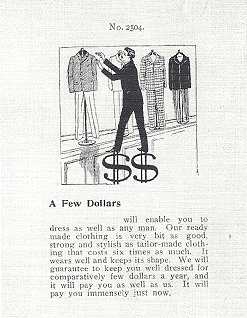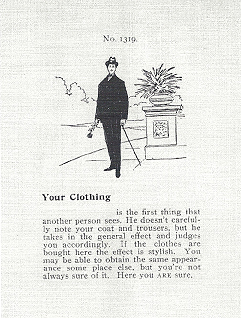Ready to wear clothing brings with it a huge compromise in every respect; proper fit, quality, and service! Compared to fine custom tailoring, you might consider fine dining compared to fast food. Society answers people’s demand for a rich product that satisfies experience or a compromise, at a cheap price. As time goes on, and fewer people have experienced the original “higher road”, they’re unaware that they have given up anything. Imaging someone who has only experienced the empty calories and the quick grab it and run approach to dining, rather than being attended to in the finest restaurant while enjoying the culinary delights of a fine professionally trained chef!

Never intended to appeal to “Gentlemen” or “Ladies” with tailors, but rather to provide inexpensive office wear for office support staff, (at 1 18th to 1/6th the price) the ready to wear industry expanded as manufacturers and retailers downplayed the compromise of fit and quality while focusing on the lower price and the “convenience” of immediate delivery.
As time went on and costs of advertising and store rents were factored in, along with the cost of overstocked unsold merchandise, the gap in price began to close. As stores grew and costs such as medical insurance, workman’s compensation, retirement plans all became a factor, the need for larger profit margins closed the gap further. Traditional “keystone” (doubling) markups began to head to 2.5 and 3 times costs, at retail alone!
When “wholesalers” found a career opportunity wedged between manufacturers and retailers, their job to call on store buyers, suddenly now three levels of business needed to make a profit,(manufacturers, wholesalers, and retailers) totaling 900% of the actual cost of materials and manufacturing. A $200 product would start on the rack, before markdowns for $1800! As profit margins pushed prices higher, alternative less expensive compromised approaches to manufacturing became necessary. The centuries-old traditional canvas interlining, requiring several days of hand stitching, which was part of every suit ever made throughout eternity through the 1960s, finally began being replaced, first on the lowest end of the price scale, and eventually 95% of all suits, with a heat transfer method of gluing a backing to the cloth; called fusing; a process which takes minutes rather than days and produces a “suit without substance”, adequate for a time, but not destined for long term serviceability or a look of importance to the wearer.
As retailers began demanding manufacturers to take back unsold merchandise and to adjust prices retroactively to allow the retailers to maintain their own guaranteed profit margins, quality went further downhill while manufacturer’s traditionally lower profit margins had to be raised to absorb the “participation” in the partnership in the success or failure of the sale of any given style or product.
Inexperienced, inexpensive help in stores gave end users little of the depth of knowledge or personal relationship they had enjoyed with the tailors who had often served two or three generations of their families. While personal tailors had often frequently visited their clients in their homes or offices, departments stores and specialty stores trained their customers to make repeated trips to the store to purchase, alter and pick up completed merchandise in a relative serve yourself manner, compared to the good old days of personal service.
Manufacturers and large chain stores and advertising agencies recognized the human need for prestige by association, so began making “stars” of designers, which meant paying large royalties, further increasing the profit margins. Designers would design and produce beautiful well-made merchandise, (albeit for an “average” body), and with high labor costs, proper handwork, canvas interlinings and top quality fabrics, the prices, after 3 distribution levels of profit would exceed the price, of a comparable suit made by’ the finest tailor, with the advantage of proper fit and personal service: a far cry from the original 1/6th to 1/8th the initial cost of ready-to-wear!
With one’s reputation in place as a designer, secondary lines of lesser made clothes would be directed to the mass market of unsuspecting buyers who had little understanding that the clothes they were buying had little in common with the top of the line garments which had made that designer’s reputation. These “lesser ” fused, inexpensively made lines, (Polo for Ralph Lauren, Mani for Georgio Armani, etc.) produce 95% of the profits for designers and stores while the top of the line 5% supports and reinforces their reputations!
Mean while, tailors unable to compete began to close up shop or those who remained were forced to eliminate their apmvnticeship and began using standard block patterns to produce a quicker, faster moving less labor intensive approach to making “semi-custom, or made-to measure suits, usually made in a factory, cut 20 at a time stacked on tables by size, (size 40, 42, 44, etc.) while “alterations” are incorporated for sleeve length, waist size, etc. to “personalize” the suit while being made.
Tailors weren’t about to tell customers of the compromised short cut approach, so those customers, assumed their clothes were custom made because they were being measured (8 to 10 measurements, only) and because they were selecting fabrics from a swatch book and styles from sketches. Due to their lack of experience, they have been slow to recognize the compromise in custom tailoring as compared to the old time, legitimate pattern making tailors who have progressively died off, giving way to a lesser approach.
Pattern making tailoring has been almost entirely replaced with the semi-custom standard pattern approach in the western world, the USA, Canada, England, Italy and Europe! Because mass-produced clothing (and standard “block patterns” were slow to make their way to the Orient, tailors from India, China, Hong Kong, trained during the occupation by the British, still produce clothing made to each individual client’s shape and distribution. However, their level of “discrimination” of proper fit often leaves a great deal to be desired, but most importantly, their access to proper components, their lack of sophisticated technique of the actual making of the
garment, and the demands to produce fast piece work at low prices to address local merchant tailors and the end buyers desire to buy at cheap prices, makes for a suit that potentially fits well, but one that may look reasonably decent in quality, only until it’s been dry cleaned a few times.
So, the choice becomes either a compromised ill fitting semi-custom fit of decently made quality in the western world, or a potentially superior fit, at the risk of lack of quality workmanship in the Orient.

Interesting, custom clothing, (rather, semi-custom clothing) is enjoying a level of attention and is becoming a fast growing segment in the market, mostly because retailers are looking for ways to increase sales without increasing their inventory costs! When sales were brisk, they weren ‘t about to be bothered with the more labor intensive, time consuming aspects of measuring, fitting, writing orders, submitting orders to factories or workshops, notifying clients of fittings or completed merchandise. Having been spoiled by putting a garment in a bag and swiping a charge card, they haven’t been concerned with the compromise of fit but now for their own survival and profit, many are seeing some of the advantages of “custom clothing” in one form or another and how they can put it to use for their own purposes.
An understanding of one’s own body will serve one well to play an active part in the outcome of the completed garment, rather than being at the mercy of the provider of any clothing which is being purchased; off-the-rack, or semi-custom.

